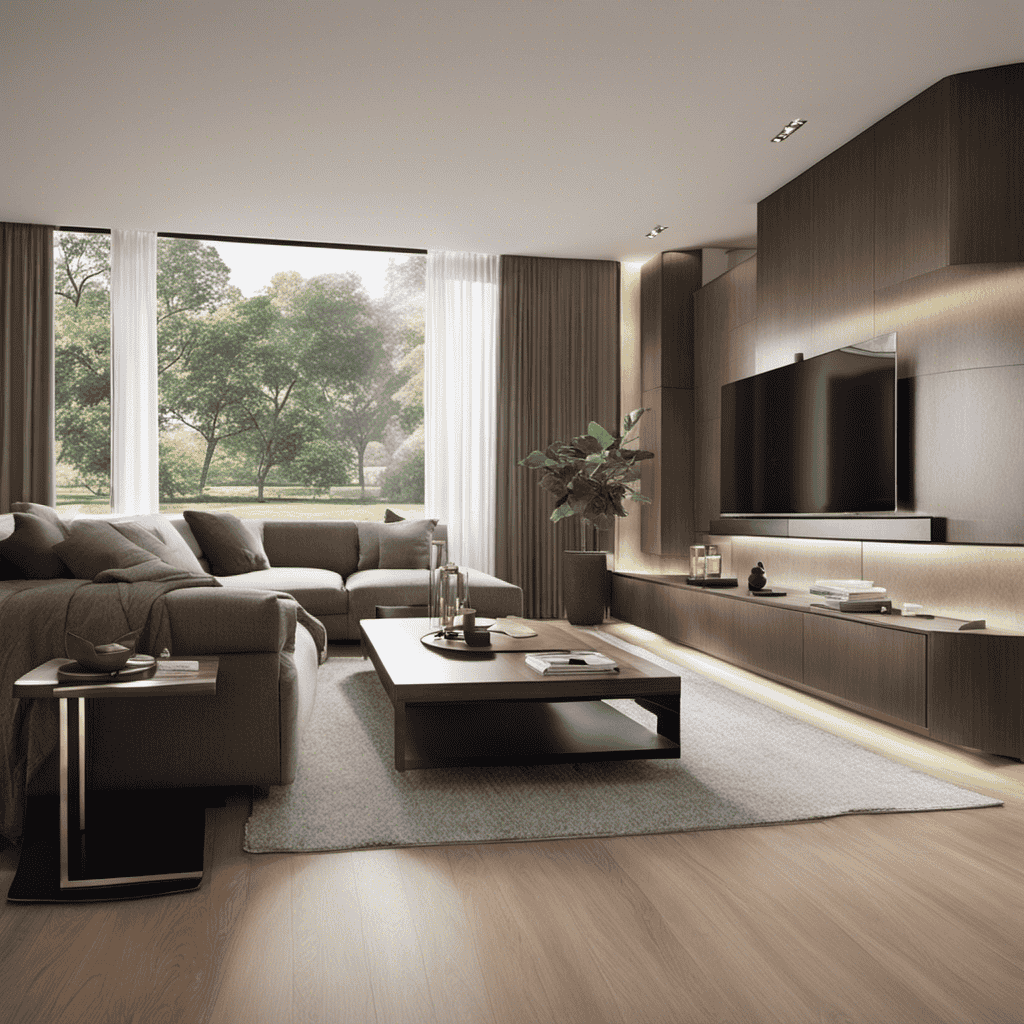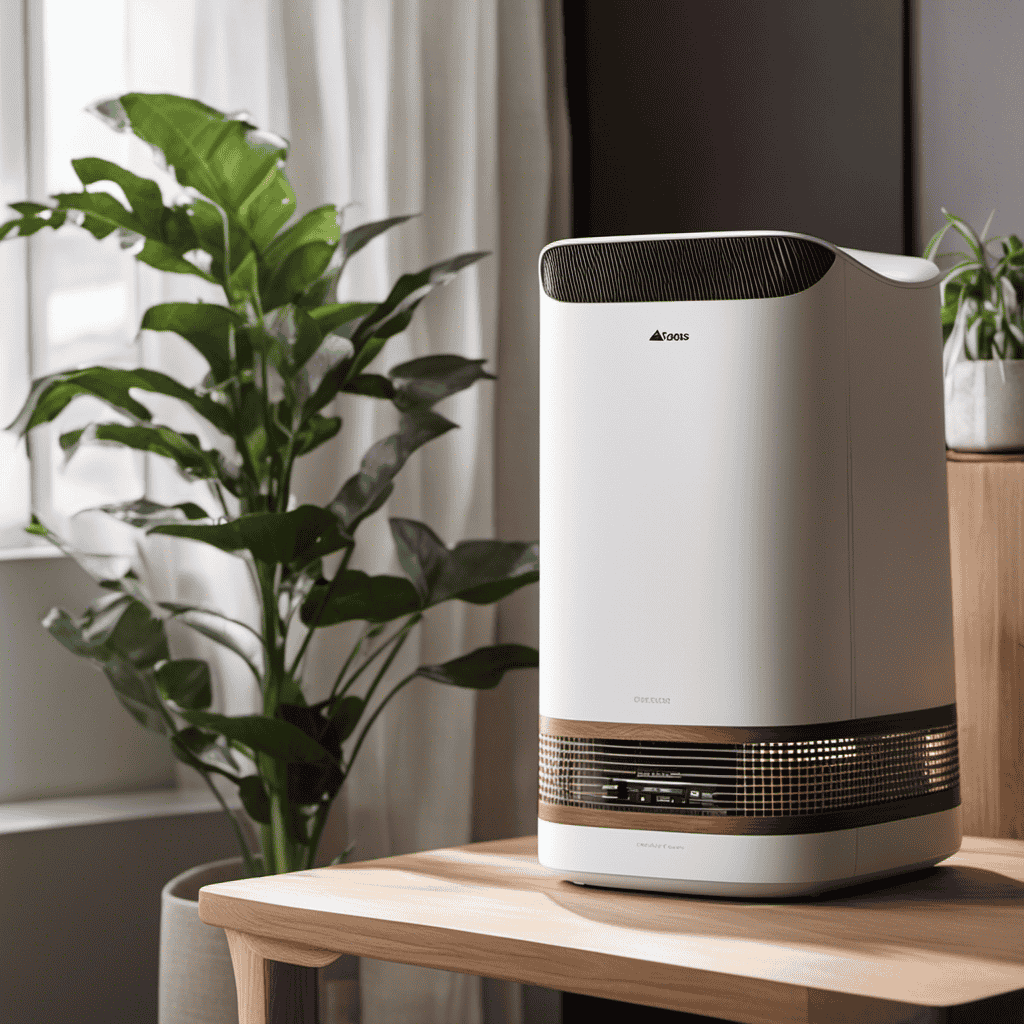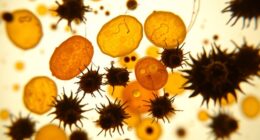As a person who suffers from allergies, I empathize with the frustration and discomfort of constantly dealing with sniffles and sneezes. That’s why I decided to investigate how air purifiers can provide relief for these symptoms.
With their advanced filtration systems, air purifiers actively and effectively remove allergens from the air we breathe. From dust mites to pet dander, pollen to mold spores, these devices play a crucial role in creating a cleaner and healthier environment.
So, let’s dive in and discover exactly how air purifiers can bring relief to allergy sufferers like me.
Key Takeaways
- Air purifiers can filter out allergens from the air and prevent them from circulating, helping to reduce allergy symptoms and flare-ups.
- HEPA filters in air purifiers are highly effective in removing smaller allergens like pollen, mold spores, and pet dander, improving indoor air quality.
- Regular use of air purifiers can create a clean and healthy environment, benefiting allergy and respiratory sufferers by reducing allergen levels.
- Air purifiers with HEPA filters can effectively capture and trap dust mite allergens, helping to eliminate them and reduce the risk of allergic reactions.
Understanding Allergies and Their Triggers
Understanding allergies and their triggers can help me make informed decisions about how an air purifier can alleviate my symptoms. Allergies occur when the immune system reacts to a substance, known as an allergen, that is normally harmless to others. Common allergens include pollen, dust mites, pet dander, and mold spores.
By avoiding these allergens, I can minimize exposure and reduce the severity of my symptoms. However, complete allergen avoidance is often difficult, especially when it comes to airborne allergens. This is where an air purifier can be beneficial.
Air purifiers work by filtering out allergens from the air, trapping them in a filter and preventing them from circulating in the room. This can provide much-needed relief from allergy symptoms and improve indoor air quality, making it easier for me to breathe and reducing the likelihood of allergy flare-ups.
How Air Purifiers Filter Allergens
When it comes to air purification, understanding the process and the efficiency of allergen removal is crucial.
Air purifiers work by using filters to capture and trap airborne particles, including allergens like pollen, dust mites, and pet dander.
The efficiency of an air purifier in removing allergens can vary depending on factors such as the type of filter used, the size of the particles, and the airflow rate.
Air Purification Process
To effectively purify the air and alleviate your allergies, you’ll want to know how an air purifier works. Here is a breakdown of the air purification process:
- Air Intake: The purifier pulls in air from the surrounding environment.
- Pre-filter: The pre-filter captures large particles like dust and pet hair.
- HEPA Filter: The High-Efficiency Particulate Air (HEPA) filter removes smaller allergens such as pollen, mold spores, and pet dander.
- Activated Carbon Filter: This filter eliminates odors and harmful chemicals.
By following proper air purifier maintenance, you can ensure its optimal performance. Regularly cleaning or replacing filters is crucial for maintaining the purifier’s effectiveness.
The benefits of air purifiers include relieving allergy symptoms, reducing asthma triggers, and improving overall air quality. With a well-maintained air purifier, you can enjoy cleaner, fresher air in your home, providing relief from allergies and promoting better respiratory health.
Allergen Removal Efficiency
The HEPA filter removes smaller allergens, such as pollen, mold spores, and pet dander, which helps improve overall air quality.
Air purifiers offer numerous benefits in terms of allergen control. By capturing and trapping these microscopic particles, they prevent them from circulating in the air and entering our respiratory system. This is especially important for individuals with allergies or asthma, as these allergens can trigger symptoms and exacerbate respiratory conditions.
Studies have shown that air purifiers can effectively reduce allergen levels in indoor environments, leading to a decrease in allergy symptoms and an overall improvement in quality of life. With regular use, air purifiers can create a clean and healthy environment by removing harmful allergens, providing relief to those who suffer from allergies or respiratory issues.
The Role of HEPA Filters in Allergy Relief
If you’re looking to alleviate your allergies, HEPA filters play a crucial role in providing relief. These high-efficiency particulate air filters are designed to capture and trap tiny particles in the air, including allergens like pollen, dust mites, pet dander, and mold spores.
Here are the benefits of using HEPA filters:
-
Improved indoor air quality: HEPA filters remove up to 99.97% of airborne particles, ensuring cleaner and healthier air for allergy sufferers.
-
Allergen reduction: By capturing allergens, HEPA filters help reduce the triggers that can cause allergic reactions.
-
Symptom relief: HEPA filters can significantly reduce allergy symptoms such as sneezing, coughing, itching, and watery eyes.
-
Better sleep: Breathing in clean air can improve sleep quality, as allergens in the air can disturb sleep patterns.
Using HEPA filters in air purifiers and vacuum cleaners can provide substantial relief for allergy sufferers, helping them breathe easier and enjoy a more comfortable living environment.
Eliminating Dust Mites With an Air Purifier
Now that we understand the role of HEPA filters in allergy relief, let’s explore how an air purifier can help in eliminating dust mites.
Dust mites are tiny creatures that thrive in warm, humid environments, commonly found in our homes. These microscopic pests can trigger allergic reactions and asthma symptoms in sensitive individuals.
Air purifiers equipped with HEPA filters are highly effective in capturing and trapping dust mite allergens present in the air. These filters have a dense fiber structure that can trap particles as small as 0.3 microns, including dust mite feces and body fragments. By continuously circulating the air and filtering out these allergens, air purifiers create a healthier indoor environment, reducing the risk of allergic reactions.
In addition, some air purifiers also feature UV-C light technology, which can help kill dust mites and other microbes that pass through the purifier. This further enhances the dust mite prevention capabilities of the air purifier.
Overall, using an air purifier with HEPA filters can significantly reduce dust mite allergens in the air, providing relief for individuals prone to allergies and asthma.
Reducing Pet Allergens in the Air
To reduce pet allergens in the air, you should regularly groom your pets and keep them out of your bedroom. This is because pet dander, which includes tiny flecks of skin, hair, and saliva, can trigger allergic reactions in sensitive individuals.
Here are some effective ways to reduce pet allergens:
- Brush your pet regularly to remove loose fur and dander.
- Bathe your pet with a hypoallergenic shampoo designed to reduce allergens.
- Vacuum your home frequently using a vacuum cleaner equipped with a HEPA filter.
- Use pet hair purification products, such as sprays or wipes, to help neutralize allergens.
Managing Pollen and Outdoor Allergens Indoors
When it comes to managing pollen and outdoor allergens indoors, there are a few key points to consider.
First, filtering outdoor allergens is crucial in maintaining a clean and allergy-free environment. Investing in high-quality air filters and regularly cleaning them can help remove pollen, dust, and other allergens from the air.
Additionally, taking preventative measures such as keeping windows and doors closed during peak pollen times and using a HEPA vacuum cleaner can help minimize the amount of pollen brought into the house.
Filtering Outdoor Allergens
If you’re dealing with outdoor allergens, an air purifier can help filter them out of your home. Outdoor pollutants like pollen, dust, and mold spores can trigger allergic reactions and worsen respiratory conditions. By using an air purifier, you can effectively remove these allergens from the air you breathe, leading to a significant improvement in your respiratory health.
Here are some ways an air purifier can help:
- Capturing pollen particles, preventing them from entering your home.
- Filtering out dust mites and pet dander, reducing allergy symptoms.
- Eliminating mold spores, preventing respiratory issues.
- Removing pollutants like smoke and smog, improving overall air quality.
Investing in an air purifier is a proactive step towards creating a healthier indoor environment and enjoying relief from outdoor allergens.
Indoor Pollen Prevention
By regularly cleaning my home and keeping windows closed, I can minimize the amount of pollen that enters my indoor environment. This is crucial for maintaining good indoor air quality and preventing allergies.
However, even with these precautions, it is difficult to completely eliminate all pollen particles from the air. This is where an air purifier can provide significant benefits.
Air purifiers are designed to capture and remove airborne allergens, including pollen, from the indoor air. They use filters and other technologies to trap these particles, ensuring that the air I breathe is clean and free from allergens.
This can greatly reduce allergy symptoms and improve overall indoor air quality, making the home a more comfortable and healthy living environment.
Addressing Mold and Mildew Allergies With an Air Purifier
An air purifier can help alleviate mold and mildew allergies by removing airborne spores and reducing the presence of these allergens in the indoor environment. Mold prevention is crucial for maintaining good indoor air quality, and an air purifier can be an effective tool in achieving this.
Here are some key benefits of using an air purifier for mold and mildew allergies:
-
Removes airborne spores: An air purifier with a HEPA filter can capture and trap mold spores, preventing them from circulating in the air.
-
Reduces mold growth: Some air purifiers are equipped with UV-C light technology, which helps kill mold and mildew spores, inhibiting their growth.
-
Eliminates musty odors: Air purifiers with activated carbon filters can effectively remove unpleasant odors associated with mold and mildew.
-
Improves overall indoor air quality: By removing mold and mildew allergens, an air purifier helps create a healthier living environment.
By addressing mold and mildew allergies with an air purifier, you can significantly improve your indoor air quality and reduce the risk of allergic reactions.
Now, let’s explore how to choose the right air purifier for allergy relief.
Choosing the Right Air Purifier for Allergy Relief
When choosing the right air purifier for allergy relief, it’s important to consider your specific needs and the features that will best address them.
Air purifiers come with a variety of features, so it’s essential to understand which ones are most effective for combating allergies. Look for air purifiers with HEPA filters, as they can capture 99.97% of allergens, such as pollen, dust mites, and pet dander.
Activated carbon filters are also beneficial, as they can remove odors and chemicals from the air. Additionally, consider air purifiers with a high CADR (Clean Air Delivery Rate) to ensure efficient air purification.
When it comes to cost effectiveness, look for air purifiers with energy-saving features and filter replacement indicators, which can help you save on long-term maintenance costs.
Frequently Asked Questions
How Often Should I Run an Air Purifier to Effectively Reduce Allergens in My Home?
To effectively reduce allergens in my home, I should run an air purifier consistently. Factors such as room size, filter type, and the level of allergens present should be considered when choosing the optimal settings for allergy relief.
Can an Air Purifier Completely Eliminate My Allergy Symptoms?
An air purifier can significantly reduce allergy symptoms, but it may not completely eliminate them. It helps by removing allergens like dust, pollen, and pet dander from the air, improving indoor air quality and providing relief.
Are There Any Side Effects of Using an Air Purifier for Allergy Relief?
There are some potential side effects of using an air purifier for allergy relief, especially with long-term use. However, the best air purifiers for pet allergies can significantly reduce allergens in the air and improve symptoms.
Can Air Purifiers Help With Asthma Symptoms as Well?
Air purifiers are beneficial for respiratory health. They can help alleviate asthma symptoms by removing allergens and pollutants from the air. I’ve experienced improved breathing and reduced asthma attacks since using one.
Are There Any Specific Air Purifier Brands or Models That Are Recommended for Allergy Sufferers?
Top rated air purifier brands for allergy sufferers include Honeywell, Dyson, and Blueair. Using an air purifier can help alleviate allergy symptoms by removing allergens like dust, pollen, and pet dander from the air.
Can an Air Purifier Help with Allergies Caused by Bad Air Quality?
Yes, an air purifier can definitely help with allergies caused by bad air quality. This is because an air purifier bad air meaning is designed to remove harmful particles and pollutants from the air, reducing the potential triggers for allergic reactions and improving overall air quality.
Can Air Purifiers also Help with Allergies in Addition to Improving Sleep and Mental Well-being?
Yes, the therapeutic powers of air purifiers can help alleviate allergy symptoms by capturing and filtering out airborne allergens like pollen, pet dander, and dust mites. By reducing allergens in the air, air purifiers can contribute to better sleep and improved mental well-being for allergy sufferers.
Conclusion
In conclusion, air purifiers are an essential tool for allergy relief. They effectively filter out allergens like dust mites, pet dander, pollen, mold, and mildew, ensuring cleaner and healthier indoor air.
With the use of HEPA filters, air purifiers can capture even the tiniest particles, providing maximum allergy relief.
So, if you’re tired of sneezing, itching, and dealing with allergy symptoms, investing in an air purifier is a wise choice. Remember, with an air purifier by your side, you can breathe easy and enjoy an allergen-free environment, like a breath of fresh air.










